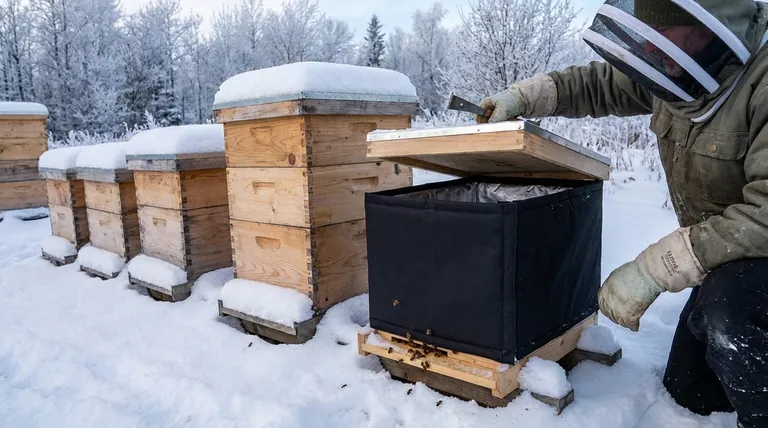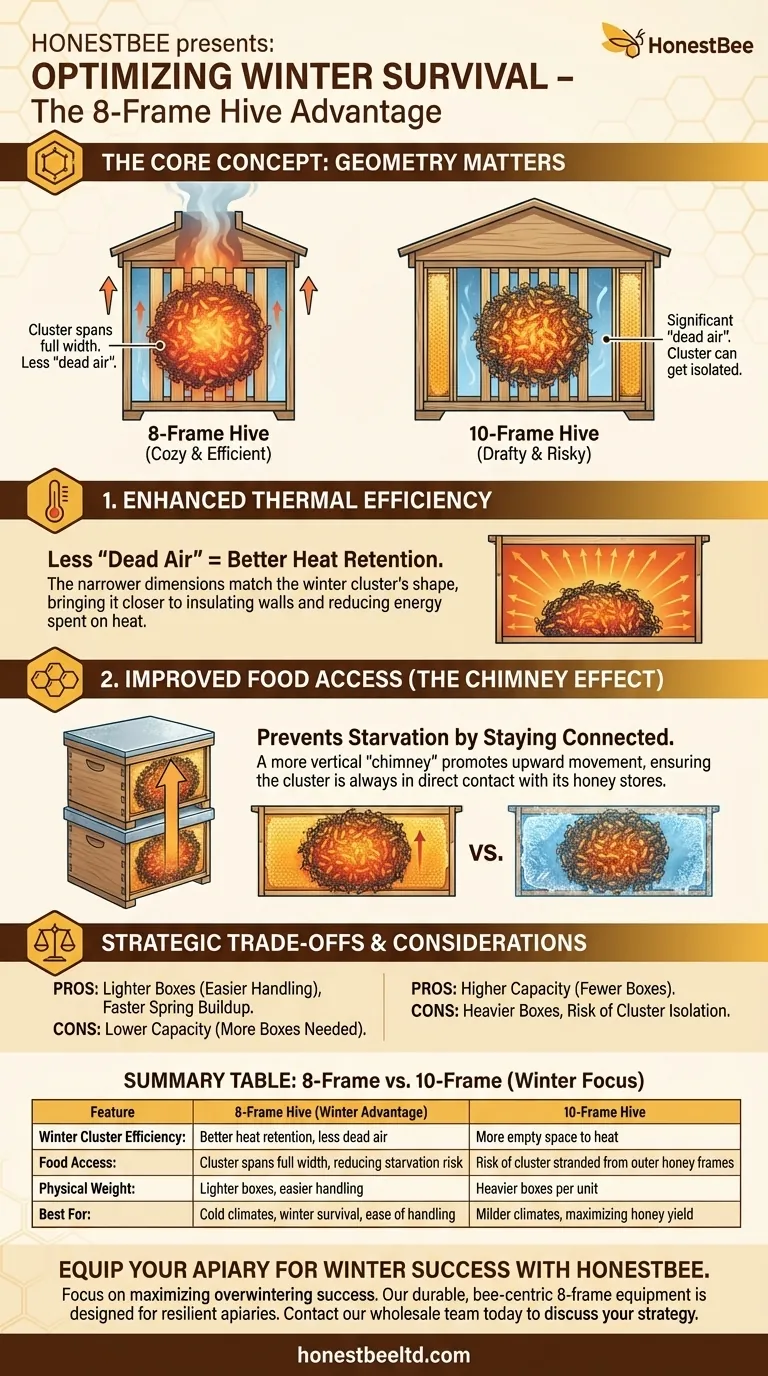In short, an 8-frame hive is often better for winter because its narrower dimensions create a space that more closely matches the natural shape and behavior of a winter bee cluster. This "cozier" environment helps the bees conserve heat and stay in direct contact with their honey stores, significantly improving their chances of survival in cold climates.
The choice between an 8-frame and a 10-frame hive is not just about size, but about geometry. The narrower 8-frame hive creates a more vertical "chimney" that aligns with a colony's natural instinct to move upward during winter, reducing the risk of the cluster starving while surrounded by food.

The Physics of the Winter Cluster
To understand why hive width matters, you must first understand how bees survive the cold. They do not heat the entire hive; they only heat the cluster they form.
How Bees Maintain Warmth
A honeybee cluster generates heat by vibrating the powerful wing muscles of thousands of individual bees. The bees on the outer layer of the cluster form a dense, insulating mantle, while the bees inside generate the warmth necessary to keep the core temperature stable.
The Problem of "Dead Air"
The less empty space, or "dead air," there is around this cluster, the more thermally efficient it becomes. An 8-frame hive, being narrower than a 10-frame, reduces this empty space on the sides of the cluster.
This means the cluster is closer to the insulating wooden walls of the hive and has less cold air to manage, allowing the bees to expend less energy on heat generation.
The "Chimney Effect"
A stacked 8-frame hive creates a taller, more column-like cavity compared to a 10-frame. This promotes a "chimney effect," where the heat generated by the cluster rises and is better contained. This vertical orientation is key to how the colony accesses its food.
Cluster Movement and Access to Food
The single greatest threat to a winter colony, aside from Varroa mites, is starvation. A hive's internal geometry plays a direct role in the colony's ability to access its stored honey.
The Upward March for Honey
In a standard Langstroth hive, a colony prepares for winter by storing honey above the brood nest. As winter progresses, the cluster consumes the honey in the frames directly above it and slowly moves upward into the higher boxes.
The Risk of a Divided Cluster
In a wider 10-frame box, the cluster may not span all the frames. It might occupy the central 6-7 frames, leaving honey untouched on the outer frames 1, 2, 9, and 10.
The critical danger is that the cluster can eat all the honey directly above it and be unwilling to move sideways across cold, empty comb to reach the honey on the outer frames. The cluster can effectively starve to death just inches away from its food source.
Why an 8-Frame Reduces This Risk
Because an 8-frame box is narrower, the winter cluster is far more likely to span the entire width of the hive. This ensures the bees are always in direct contact with their honey stores as they move upward. There are no cold, inaccessible frames of honey for the cluster to get stranded from.
Understanding the Trade-offs
The 8-frame hive is not universally superior; it comes with a distinct set of trade-offs that are important to consider for your specific beekeeping goals.
Less Storage Capacity
The most obvious downside is that an 8-frame box holds less honey and provides less room for brood than a 10-frame box. This means you may need to use more boxes (i.e., a taller stack) to provide adequate winter stores or honey surplus space.
Physical Weight vs. Number of Boxes
Individual 8-frame boxes are significantly lighter and easier to lift, reducing physical strain. However, because you may need more of them, you could end up handling a greater total number of boxes throughout the season.
Faster Spring Buildup and Swarm Pressure
The smaller brood area can be filled more quickly by a strong queen in the spring. This can accelerate swarm preparations, requiring the beekeeper to be more vigilant with swarm management techniques earlier in the season.
Making the Right Choice for Your Apiary
The decision to use 8-frame or 10-frame equipment should be based on your climate, your physical abilities, and your primary goals as a beekeeper.
- If your primary focus is maximizing winter survival in a cold climate: The thermal efficiency and cluster-centric design of the 8-frame hive provide a clear advantage.
- If your primary focus is maximizing honey production in a milder climate: The larger capacity of the 10-frame hive may be more efficient, requiring fewer boxes to manage.
- If your primary focus is reducing the physical strain of beekeeping: The lighter weight of 8-frame boxes makes them the undeniable winner for ease of handling.
Ultimately, selecting the right equipment is about understanding how the hive's design supports the natural biology of the bees within it.
Summary Table:
| Feature | 8-Frame Hive (Winter Advantage) | 10-Frame Hive |
|---|---|---|
| Winter Cluster Efficiency | Better heat retention, less dead air | More empty space to heat |
| Food Access | Cluster spans full width, reducing starvation risk | Risk of cluster stranded from outer honey frames |
| Physical Weight | Lighter boxes, easier handling | Heavier boxes per unit |
| Honey Production | Lower per-box capacity | Higher per-box capacity |
| Best For | Cold climates, winter survival, ease of handling | Milder climates, maximizing honey yield |
Equip Your Apiary for Winter Success with HONESTBEE
Are you a commercial apiary or equipment distributor focused on maximizing overwintering success? The thermal efficiency and bee-centric design of 8-frame hives can be a game-changer for colony survival in cold climates.
HONESTBEE supplies durable, high-quality 8-frame hive equipment through our wholesale-focused operations, helping you build resilient apiaries. Our equipment supports the natural winter behavior of bees, promoting healthier colonies and more predictable outcomes.
Contact our wholesale team today to discuss how our 8-frame hive supplies can strengthen your winter beekeeping strategy and improve your bottom line.
Visual Guide

Related Products
- Professional Insulated Winter Hive Wrap for Beekeeping
- Professional 3-Bar Frame Grip with Integrated Hive Tool
- Professional Insulated Plastic Bee Hives
- HONESTBEE Advanced Ergonomic Stainless Steel Hive Tool for Beekeeping
- HONESTBEE Professional Multi-Functional Hive Tool with Ergonomic Wood Handle
People Also Ask
- What are the benefits of insulated beehives in cold weather? Boost Winter Survival & Spring Productivity
- What is the advantage of an insulated outer cover? Boost Winter Survival & Spring Buildup
- What are the steps to properly wrap a beehive for winter? Ensure Your Colony Survives the Cold
- What are the durability features of Bee Blankets? Built to Last in Demanding Apiary Conditions
- How does insulation help bee hives in severely cold weather? Conserve Energy & Ensure Colony Survival



















